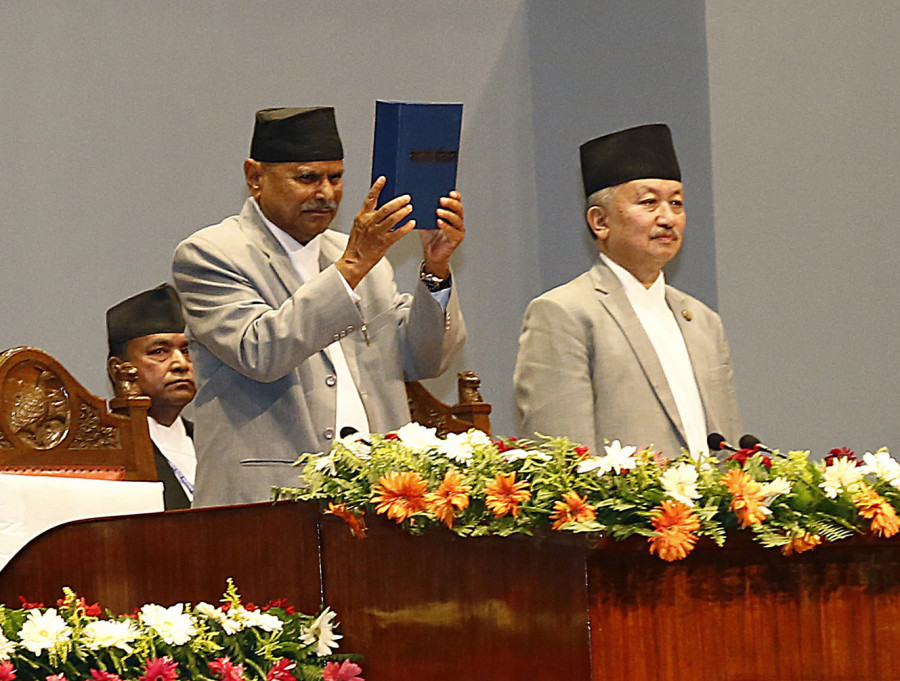Columns
Achievements of the federal constitution
The need to travel to the district headquarters and even Kathmandu for small tasks has been completely reduced.
Khim Lal Devkota
Nepal's federal constitution was promulgated in 2015, but its formal implementation started only in 2017. The greatest achievement of this constitution is to ensure a federal democratic republic with a multiparty competitive system of governance, periodic elections, an independent judiciary, human rights, fundamental rights and complete freedom of the press as constitutional rights. After the promulgation of the constitution, the state structure of the country has undergone great changes. State power in the former unitary system has been divided into three levels of government; accordingly, the provincial and local governments have been functioning in a new federal set-up.
The organisational structure of the three tiers of government (federal, provincial and local) has been prepared, and most of the work related to staff adjustment has been completed. The sub-federal governments have reached the stage of making laws, making annual budgets, making decisions, formulating policies and plans, and implementing them within their economic jurisdiction.
A novel experiment
In terms of fiscal federalism, the constitution has assigned responsibilities to the sub-federal levels, including revenue-raising powers, fiscal transfers and borrowing. Regarding fiscal transfers, the provincial and local governments have been receiving all four types of grants stated in the constitution: fiscal equalisation, conditional, special and matching grants. The sub-federal levels have also been receiving revenue sharing from value-added tax and excise duty, and royalty from natural resources.
The constitution provides for a National Natural Resource and Fiscal Commission as a constitutional body to work in matters related to fiscal transfers. The commission has been formed and it has started its work. Fiscal transfers have been made not only from the federal government but also from the provincial governments to their respective local governments. The constitution has been promulgated to achieve economic equality and social justice by ending all kinds of discrimination and inequality including the existing ethnic, geographical, cultural and gendered differences in the previous unitary system. After the promulgation of the constitution, the country has shown many signs of change and reform.
The constitution lists exclusive and concurrent powers for the three levels of government. These powers were elaborated through an unbundling exercise carried out to resolve possible disputes between the federal units. Based on this unbundling exercise, the division of work responsibilities of the council of ministers of the federal and provincial governments (Allocation of Business Rules), Intergovernmental Fiscal Arrangement Act 2017 and Local Government Operation Act 2017 have been prepared. This exercise has laid the foundation for the implementation of federalism in Nepal.
With the transfer of constitutional powers and responsibilities to the sub-federal levels, new organisational structures and staffing of government services have been determined. The work of integrating the existing government employees of the civil service in all the federal units based on approved organisational structures and personnel is almost complete.
Inter-governmental coordination agencies such as the Inter-Provincial Council (chaired by the prime minister for resolving political disputes between the federal and provincial governments), Intergovernmental Fiscal Council (chaired by the finance minister to consult fiscal issues between the federal units) and Provincial Coordinating Council (chaired by the chief minister to coordinate planning and budgeting issues between the provincial and local levels) have been formed, and some visible work has been initiated. The federal Parliament recently enacted an inter-governmental coordination law. The law comprises the basis of inter-governmental relationships between the federal units, guidelines to prepare legal documents, policy and planning, a basis for drafting laws for exclusive and concurrent powers, settlement of intergovernmental disputes, and formation of the National Coordination Committee and sectoral committees.
The formation of the three tiers of government represents a novel experiment in Nepal’s federal journey. A few problems and uncertainties cropping up are but natural in a new system of governance. Some difficulties have emerged, particularly in the exercise of power. The provincial governments have been complaining that the centre has not been very cooperative when it comes to staff appointment and retention, capacity building, land acquisition, formulation of laws, devolution of authority and allocation of resources. The local governments have also complained to the federal and provincial governments that they have not been cooperating fully in the planning system.
Further, there is still some disagreement between some sections and regions towards the constitution. There is a provision in the constitution that it can be amended in a way that is not against the sovereignty, geographical integrity, independence and sovereignty of the people. Voices of dissatisfaction need to be addressed with care and diligence. However, the fact that the powers of Singha Durbar have reached the doorsteps of the people due to the federal constitution cannot be ignored. The constitution has made citizens more powerful.
Signs of improvement
The citizens have reached a position of being able to work in the local and provincial governments. With a few exceptions, there are signs of improvement in almost all areas. A sense of positive competition has been created between different local and provincial governments. Thoughts have been developed on how to strengthen financial means and resources, how to make maximum development with limited means and resources, and how to provide services to the citizens in a comfortable and easy way. The people have found the government at their doorsteps.
Peace and stability have emerged in the country. The need to travel to Kathmandu, or to even the district headquarters for that matter, for small tasks has been completely reduced. Further, to some extent, internal migration has also been controlled. To carry the momentum and reduce friction, inter-governmental relations and coordination need to be continuously active to foster cooperation between the tiers of government. Constructive vigilance from all spheres of society, including civil society and the media, is also necessary. There have been many achievements in the short period since the promulgation of the constitution. However, despite the achievements, there is great dissatisfaction among the citizens—discontent among Madhesis and other minority or vulnerable groups being a major one. According to the dreams and aspirations of the people, the federal, provincial and local levels have not been able to work as expected. Governments at all three levels need to seriously review their work and attitude. Lastly, it is important to seriously review the implementation of the constitution including federalism at the political level.
***
What do you think?
Dear reader, we’d like to hear from you. We regularly publish letters to the editor on contemporary issues or direct responses to something the Post has recently published. Please send your letters to [email protected] with "Letter to the Editor" in the subject line. Please include your name, location, and a contact address so one of our editors can reach out to you.




 13°C Kathmandu
13°C Kathmandu















